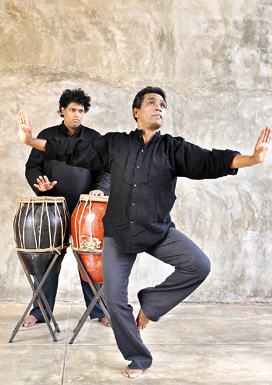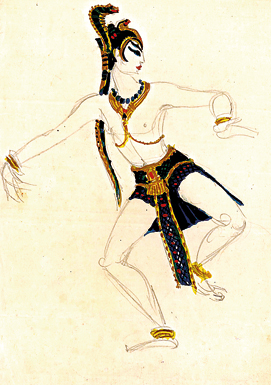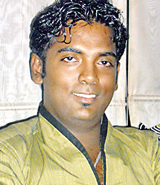In step: From father to son
Ravibandu Vidyapathi dances alongside the ghost of his father. Their shadows follow the two dancers as they leap and twist and then fold into each other. A little later, when Somabandu Vidyapathi’s sketches are projected onto the large screen at the Punchi theatre, they fill the space with dancers dressed in glorious costumes, frozen as if in mid-performance. Finally, Ravibandu steps forward alone: he is his father’s legacy personified.

In motion: Ravibandu, one of Sri Lanka’s leading artistes. Pic by Indika Handuwala
When asked to choose an ‘archive’ to draw from for his performance at the Goethe Institute’s Colombo Dance Platform, Ravibandu knew he need look no further than his parent for inspiration. (Jithendra Vidyapathi, Priyantha Dissanayake and Menika van der Poorten collaborated with him on the performance). One look at Somabandu’s gorgeous murals in the temple at Bellanwila convinced curator Ong Ken Sen that the artist had the right idea.
Accordingly, an exhibition featuring Somabandu’s sketches, many of which had been shown only once or twice before, launched the festival. However, the archive Ravibandu would draw on for his performance went beyond the paintings and was anchored instead in his intangible inheritance.
The leader of the famed Ravibandu Drum Ensemble will tell you he is his father’s son in every way that matters. Describing a sequence from the duet with his student Dayan Champika, where one figure seems to emerge out of the other, he says: “I wanted to show that intellectually and artistically, I was born out of my father.”
An iconic Sri Lankan designer, dancer and painter, Somabandu belonged to a line of dancers and temple painters. He was 82 years old when he died in 2006. In his lifetime, an all-encompassing artistic curiosity would fuel a rich aesthetic, one that he was determined to share with his children. Today, his eldest son is counted among the ranks of the island’s most talented artistes. He has performed all over the world – most notably at the Kennedy Center – and has shared a stage with world renowned musicians like Trilok Gurtu, Bill Cobham and Zakir Hussain. The dancer and drummer combines in his performances impeccable technique, a love of traditional art forms and a commitment to going beyond them.
In the coming months, Ravibandu will be labouring over a retrospective of some his most famous works. Come March, he hopes to stage his pieces inspired by Macbeth and the Ramayana as well as excerpts from his dance dramas, ballets and abstract works. He says he is also interested in how he can use his art to reflect on the heavy losses the war has inflicted on our families. Additionally, he has begun work on what he envisions will be ‘A trilogy of Othello’: Othello as a solo, as a short symbolic dance piece and finally as a full length ballet, all to be performed in a single evening.
Without his father to read them to him, Ravibandu may never have fallen in love with Shakespeare’s plays. The Jathaka stories and the film Ben Hur; the Iliad and Pandit Ravi Shankar’s music; the poetry of Rabindranath Tagore and the music of Beethoven and Bach – they were all Somabandu’s gifts to his sons. This far ranging exposure to seminal pieces of art and literature was part Somabandu’s idea of what it meant to raise a child well: “He did it deliberately in order to build my taste in art,” says Ravibandu recalling being taken for shows and exhibitions and being introduced to all manner of artists.
Ravibandu has been dancing since he was 13 years old. His gurus, Vajira and Chitrasena would remain lifelong confidantes and colleagues of Somabandu. (The bond was made closer by the fact that Somabandu’s first teacher had been Chitrasena and that Chitrasena’s first teacher, Kiriganitha Gurunnanse, was also Somabandu’s father in law.) Remembering her young student, Vajira told the Sunday Times that “Ravi simply had talent oozing out of him,” – he could sing, dance, paint and play the drums. Like Somabandu, Ravi was quiet and restrained. “Ravi takes after his father,” says Vajira.

While still her student, Ravi had to choose between the drums or dancing. “They say that the drummer and the dancer are like husband and wife. They must understand each other,” he says. “We have a lot of improvisation in our traditional dance and without that understanding the improvisation would not be possible.” Though Ravibandu’s incontestable mastery of traditional Sri Lankan drums has made him famous he sees himself primarily as a dancer. “I love to dance. Now I love to choreograph to make others dance but drumming has also always been my passionůmy second love.”
Like his father before him, Ravibandu would study the South Indian dance form of Kathakali.
“It influenced my practice,” he reveals, highlighting in particular the “histrionics or abhinaya” that are such a part of a Kathakali performance. “Kathakali also goes closely together with the kinetics of the Kandyan dance,” he adds.
More than one contemporary Sri Lankan dancer has followed the same path, and Ravibandu remembers his father’s vast collection of books and pictures on the subject. In Somabandu, the “meticulous study” of the dramatic costumes and elaborate makeup of Kathakali would influence his designs for Sri Lankan artists, producing a unique set of work. “I love the rhythm in his art. It is so very dramatic.”
The revival of interest in his father’s work has come at a good time. That night at the Punchi Theatre, with his father Somabandu’s art at his back and his son Jithendra accompanying him on the drums and vocals, Ravibandu’s performance encompassed three generations. When asked what he would like his son to know about his grandfather, Ravibandu’s response is simple: “Everything.”
Follow @timesonlinelk
comments powered by Disqus





















